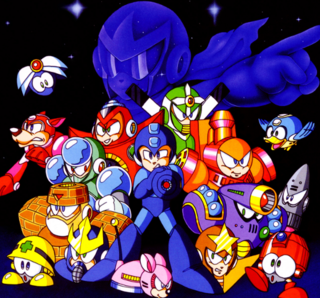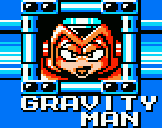Overview

Mega Man 5 (known in-game as Mega Man V, not to be confused with the Game Boy game Mega Man V, and known in Japan as Rockman 5: Blues no Wana!?, which loosely translates to "Rockman 5: The Trap of Blues?!") is a side-scrolling action platformer developed and published by Capcom for the Nintendo Entertainment System on December 1992.
It is the fifth installment of the original Mega Man series (and the sequel to Mega Man 4). Along with an improved Mega Buster, protagonist Mega Man can now collect eight circuit chips to help assemble Beat, a robotic bird (created by both his creator Dr. Light and his new ally Dr. Cossack) that can automatically attack enemies around him.
Set in the year 20XX, the game takes place months after the events of Mega Man 4 (in which the humanoid robot hero Mega Man defeats the evil roboticist Dr. Wily a fourth time). Proto Man, brother and ally to Mega Man, goes rogue and creates an army of robots to set out destructive attacks all over the world. When Proto Man kidnaps Dr. Light, Mega Man (now with upgrades by his new ally, Dr. Cossack) sets out to rescue him and deliver justice to Proto Man's army.
Gameplay
Following in Mega Man tradition, Mega Man 5 challenges the player with defeating eight robot masters who can be taken down in any order. Defeating a robot master gives Mega Man that master's power. Each robot master has a distinct weakness to one of the other master's power, leaving the player to deduce the optimal order in which to tackle the stages.
Mega Man 5 is the second game in the series to feature the chargeable Mega Buster. A fully-charged blast covers a larger vertical swath than in Mega Man 4, taking on a larger, rounder, "hadoken"-like shape as opposed to its previous comet-like shape. However, if Mega Man is hit while charging, he loses whatever charge he had built up, requiring the player to re-start the charge from nothing. This is a change from the previous game and other charge weapons (such as the Atomic Heat from Mega Man 2 and Pharaoh Shot from Mega Man 4), where Mega Man can hold the full charge of the weapon no matter when or how often he is hit. Thus, Mega Man 5 requires the player to be much more careful about dodging attacks if s/he is looking to let a full blast loose.
Rush, Dr. Light's robotic dog helper, returns from Mega Man 3 and 4 in order to assist Mega Man's progress through the game. Similar to Mega Man 4, the Rush Jet cannot be completely controlled; it propels forward in the same direction and the player can only guide it up or down. The Rush Coil behaves differently from past games. Whereas in the past Rush would offer a spring-board off of which Mega Man could jump, in Mega Man 5, the Rush Coil itself becomes a platform, propelling itself upwards once Mega Man jumps aboard. Mega Man can then leap off of it at any time.
Fliptop / Eddie also returns to offer Mega Man an array of powerups, from life and weapon replenishments to 1ups and E-tanks.
The M-tank makes an appearance in Mega Man 5; whereas consuming an E-tank replenishes all of Mega Man's health, the M-tank replenishes health as well as all weapon energy.
Each stage has an optional letter to collect; together, the letters spell M-E-G-A-M-A-N-V. These are the aforementioned circuit chips that result in Beat's assembly. As the letters are often placed in precarious spots, it's possible for the player to miss them. Mega Man 5 allows the player to re-enter the stage of any robot master that has already been defeated so that the player can try again to collect the letter. When summoned, Beat accompanies Mega Man and flies around to defeat visible enemies on screen. Beat is only available for as long as the weapon energy allows and is ineffective in some boss encounters.
Bosses
 Gravity Man
Gravity Man- Weapon: Gravity Hold
- Weakness: Star Crash
Gravity Man's level features points that shift the gravity, causing Mega Man to run along the ceiling and jump towards the floor. The controls for sliding are also reversed, requiring the player to hold UP + Jump instead of DOWN + Jump. When Mega Man triggers these gravity-shifting points, enemies will also flip--those on the floor will float up to the ceiling and vice versa.
 Wave Man
Wave Man- Weapon: Water Wave
- Weakness: Charge Kick
Wave Man's level features cracks in the floor where hot jets of steam can damage unwary players. It also features a segment where Mega Man must hop between rising bubbles of varying sizes--the smaller ones will eventually pop under his weight, while larger ones will hold, forcing the player to time jumps correctly in order to ascend unscathed. Additionally, there's an auto-scrolling motoarboat section; during it, Mega Man pilots a watercraft along the surface of the water, always facing forward but having to deal with enemies in front of him, behind him, and jumping at him. He cannot use his charge beam nor change weapons (and thus the player can't even get to the pause screen to use an E tank). Contrary to what one might expect, Wave Man does not actually feature sections where Mega Man is submerged in water.
 Stone Man
Stone Man- Weapon: Power Stone
- Weakness: Napalm Bomb
Stone Man's level is a quarry-themed environment similar to what Mega Man navigated to defeat Guts Man, Hard Man, and Drill Man. Series' veteran Metall takes up residence here, this time splitting into three tiny Metalls when struck.
 Gyro Man
Gyro Man- Weapon: Gyro Attack
- Weakness: Gravity Hold
Gyro Man's level takes place in the clouds. The two most dangerous segments include a long run through collapsing platforms while being assailed from above, immediately followed by an "elevator" segment where Mega Man must navigate on a rising platform that puts him in contact with one-hit killer spikes bearing down on him from above.
 Star Man
Star Man- Weapon: Star Crash
- Weakness: Water Wave
Where one might have assumed Wave Man's level to feature submersion and floaty jumps, in fact it's Star Man's stage that allows Mega Man to jump incredibly high. After an initial segment where meteors fall from above, Mega Man will face the typical one-hit killer spike gauntlets from above and below that will force the player to feather the Jump button carefully.
 Charge Man
Charge Man- Weapon: Charge Kick
- Weakness: Power Stone
Charge Man is essentially a locomotive--and so is his level. Mega Man must board and navigate a moving train in order to get to Charge Man. The Metalls in this stage have their fun assaulting Mega Man aboard miniature locomotives.
 Napalm Man
Napalm Man- Weapon: Napalm Bomb
- Weakness: Crystal Eye
Napalm Man's level is somewhat similar in style to the rock quarry staging found in Stone Man's stage. There is a light jungle element to some parts, as well, and robot tigers leap at Mega Man from various vantage points. Also featured are missiles that break apart upon contact with anything else, and whose shrapnel can still damage Mega Man.
 Crystal Man
Crystal Man- Weapon: Crystal Eye
- Weakness: Gyro Attack
Crystal Man's surroundings evoke a similar otherworldly, crystalline (fittingly) theme to Gemini Man's stage from Mega Man 3. Its most dangerous hazard comes in the form of chutes that drop chunks of crystal upon Mega Man's head, at varying and seemingly erratic patterns, while he is trying to navigate perilous jumps over chasms.
Ports & Re-releases
While the original game was released as a Virtual Console title for the Wii (on June 16, 2011), Nintendo 3DS (on May 16, 2013), and Wii U (on August 7, 2014), the game received some ports:
Log in to comment